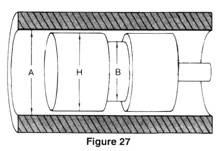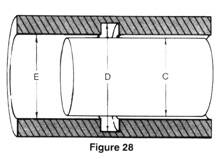|
OSCILLATING SEALS - The inner or outer member of the
assembly moves in an arc relative to the other, rotating one
of the members in relation to the O-Ring. Sealing can be
complicated by the fact that the O-Ring can snake or bunch in
the gland. The relative motion of the moving part to the fixed
part tries to carry its O-Ring contact with it, distorting the
rubber circumferentially. Many oscillating seals utilize
standard reciprocating design parameters or slight
modifications to reduce friction.
ROTARY SEALS - Rotary seals are where an inner or
outer member of the sealing assembly revolves around the shaft
axis in only one direction. The direction may be reversed.
Should there be multiple brief arcs of motion, the designer
should refer to parameters for oscillating seals.
 |
RECIPROCATING SEALS - These seals are designed much
like static radial seals except for dynamic applications the
squeeze is less likely to reduce friction and heat buildup.
There are two types of reciprocating seals - male or piston
gland design (Fig. 27) and female or rod gland design
(Fig. 28).
MALE or PISTON RECIPROCATING SEALS - The design
parameters for this type of seal are as follows:
Bore dimension (A)
Piston Dimension (H)
Groove
Dimension (B)
Groove Width (G)
FEMALE or ROD RECIPROCATING SEALS - The design
parameters include the following:
Bore dimension (e)
Rod Dimension (C)
Groove Dimension
(D)
Groove Width (G)

|